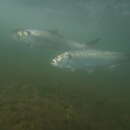en
names in breadcrumbs


Alosa agone is a species of ray-finned fish in the genus Alosa.[2] It is an endangered species.[3]
Alosa agone are common in the Mediterranean and the western Balkans.[3] There are also landlocked populations found in Italy.[3] The distribution of reproductive communities and the conservation status of Alosa agone in the central and eastern parts of the Mediterranean areas are poorly known.[3]
The numbers of Alosa agone have declined due to barriers such as dams in their local areas.[3] These barriers prevent them from getting upstream to their spawning grounds and reproducing.[3] Improved water quality in some landlocked lakes has increased their numbers in recent years.[3]
The "twaite shad" are known to be very adaptive and variable as they form landlocked populations in Italy and its neighboring areas, including the western Balkans.[3] They can modify their morphology and biology according to their environment.[3] Therefore, Alosa agone, just like many Alosa species, can be either marine or freshwater fish.
Alosa agone is a species of ray-finned fish in the genus Alosa. It is an endangered species.